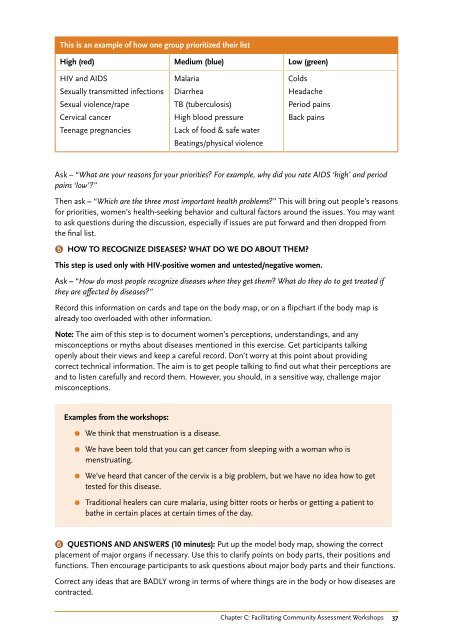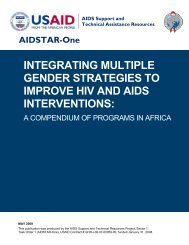Guide for Community Assessments on Women's Health Care - ICRW
Guide for Community Assessments on Women's Health Care - ICRW
Guide for Community Assessments on Women's Health Care - ICRW
Create successful ePaper yourself
Turn your PDF publications into a flip-book with our unique Google optimized e-Paper software.
This is an example of how <strong>on</strong>e group prioritized their list<br />
High (red) Medium (blue) Low (green)<br />
HIV and AIDS<br />
Sexually transmitted infecti<strong>on</strong>s<br />
Sexual violence/rape<br />
Cervical cancer<br />
Teenage pregnancies<br />
Malaria<br />
Diarrhea<br />
TB (tuberculosis)<br />
High blood pressure<br />
Lack of food & safe water<br />
Beatings/physical violence<br />
Colds<br />
Headache<br />
Period pains<br />
Back pains<br />
Ask – “What are your reas<strong>on</strong>s <str<strong>on</strong>g>for</str<strong>on</strong>g> your priorities? For example, why did you rate AIDS ‘high’ and period<br />
pains ‘low’?”<br />
Then ask – “Which are the three most important health problems?” This will bring out people’s reas<strong>on</strong>s<br />
<str<strong>on</strong>g>for</str<strong>on</strong>g> priorities, women’s health-seeking behavior and cultural factors around the issues. You may want<br />
to ask questi<strong>on</strong>s during the discussi<strong>on</strong>, especially if issues are put <str<strong>on</strong>g>for</str<strong>on</strong>g>ward and then dropped from<br />
the final list.<br />
➎ HOW TO RECOGNIZE DISEASES? WHAT DO WE DO ABOUT THEM?<br />
This step is used <strong>on</strong>ly with HIV-positive women and untested/negative women.<br />
Ask – “How do most people recognize diseases when they get them? What do they do to get treated if<br />
they are affected by diseases?”<br />
Record this in<str<strong>on</strong>g>for</str<strong>on</strong>g>mati<strong>on</strong> <strong>on</strong> cards and tape <strong>on</strong> the body map, or <strong>on</strong> a flipchart if the body map is<br />
already too overloaded with other in<str<strong>on</strong>g>for</str<strong>on</strong>g>mati<strong>on</strong>.<br />
Note: The aim of this step is to document women’s percepti<strong>on</strong>s, understandings, and any<br />
misc<strong>on</strong>cepti<strong>on</strong>s or myths about diseases menti<strong>on</strong>ed in this exercise. Get participants talking<br />
openly about their views and keep a careful record. D<strong>on</strong>’t worry at this point about providing<br />
correct technical in<str<strong>on</strong>g>for</str<strong>on</strong>g>mati<strong>on</strong>. The aim is to get people talking to find out what their percepti<strong>on</strong>s are<br />
and to listen carefully and record them. However, you should, in a sensitive way, challenge major<br />
misc<strong>on</strong>cepti<strong>on</strong>s.<br />
Examples from the workshops:<br />
●●<br />
●●<br />
●●<br />
●●<br />
We think that menstruati<strong>on</strong> is a disease.<br />
We have been told that you can get cancer from sleeping with a woman who is<br />
menstruating.<br />
We’ve heard that cancer of the cervix is a big problem, but we have no idea how to get<br />
tested <str<strong>on</strong>g>for</str<strong>on</strong>g> this disease.<br />
Traditi<strong>on</strong>al healers can cure malaria, using bitter roots or herbs or getting a patient to<br />
bathe in certain places at certain times of the day.<br />
➏ QUESTIONS AND ANSWERS (10 minutes): Put up the model body map, showing the correct<br />
placement of major organs if necessary. Use this to clarify points <strong>on</strong> body parts, their positi<strong>on</strong>s and<br />
functi<strong>on</strong>s. Then encourage participants to ask questi<strong>on</strong>s about major body parts and their functi<strong>on</strong>s.<br />
Correct any ideas that are BADLY wr<strong>on</strong>g in terms of where things are in the body or how diseases are<br />
c<strong>on</strong>tracted.<br />
Chapter C: Facilitating <str<strong>on</strong>g>Community</str<strong>on</strong>g> Assessment Workshops 37

















